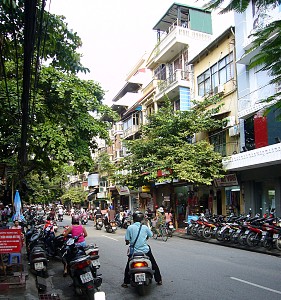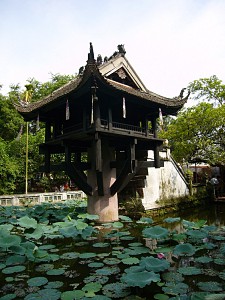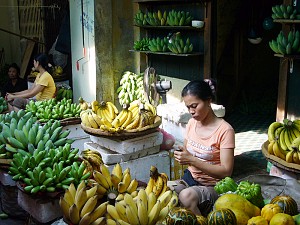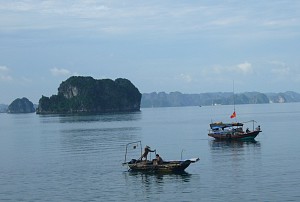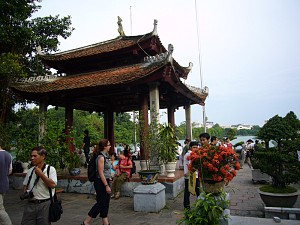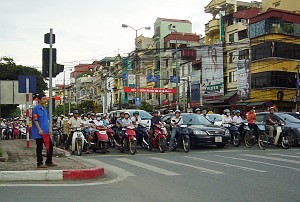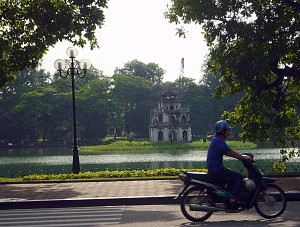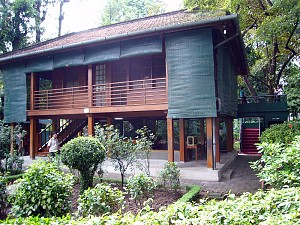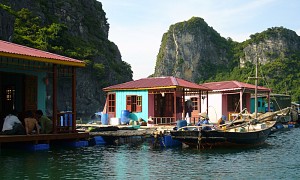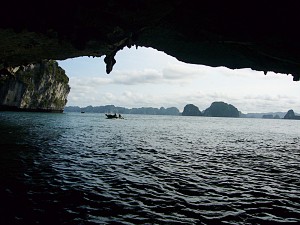Information about Vietnam, Practical Information, Places to see in Hanoi, Places to visit around Hanoi, and Vietnam highlights and pictures from Hanoi and Vietnam
Information about Vietnam
General introduction
Welcome to another world, a world where the colours are more vivid, the culture is richer, and the history more compelling. This is the world of Vietnam, the latest Asian dragon to awake from its slumber. Nature has blessed Vietnam with a bountiful harvest. With soaring peaks like Hoang Lien mountains and a killer coastline, with beaches like Quy Nhon and Nha Trang, Vietnam is simply stunning. Blanketed from head to toe with a patchwork of emerald-green rice paddies, timelessly tended by peasant women in conical hats, this time the brochures don't lie.
The rumble of a million motorbikes, the cries of hawkers and the buzz of business transactions are as ever-present as the tinkle of the past in the pagodas, and the swish of the scythe. Modern Asia meets medieval Asia and, in the Old Quarter of Hanoi, the two become one. For culinary adventurers, Vietnam is a treasure trove of more than 500 different dishes. It's a wonderful world of pungent herbs and secret spices. Dip delicate spring rolls in nuoc mam, a fish sauce that is as compulsory as ketchup for the Vietnamese. Or play 'down-in-one' with xeo (rice wine), the whisky of the mountains.
Fast facts of Vietnam
-
Mainland Territory: 329,314 sq. km
-
Population: 83,119,900 inhabitants (in 2005)
-
National Capital: Hanoi
-
Lying on the eastern part of the Indochinese peninsula, Vietnam is a strip of land shaped like the letter “S”. China borders it to the north, Laos and Cambodia to the west, the East Sea to the east and the Pacific Ocean to the east and south.
-
The country’s total length from north to south is 1,650km. Its width, stretching from east to west, is 600km at the widest point in the north, 400km in the south, and 50km at the narrowest part, in the centre, in Quang Binh Province. The coastline is 3,260km long and the inland border is 4,510km.
-
Latitude: 102º 08' - 109º 28' east
-
Longitude: 8º 02' - 23º 23' north
-
Vietnam is also a transport junction from the Indian Ocean to the Pacific Ocean.
-
Climate: Vietnam lies in the tropics and monsoon.
-
Topography: Three quarters of Vietnam's territory consist of mountains and hills.
-
Administrative Units: Vietnam is divided into 63 provinces and cities.
Practical information
How to come to Vietnam
Vietnam is the easternmost nation of Indochinese Peninsula. Located close to South China Sea from the eastern side it borders China, Laos and Cambodia from north, northwest and southwest respectively. Therefore it is very easy to get to Vietnam as it is accessible by all modes and from all corners of the world.
- By air: Getting to Vietnam by means of air is the best way to reaching the country. Several countries offered direct flights to and from Vietnam. However flights from long distance destinations are limited. Vietnam has four international airports that take care of all air travel. The Hanoi International Airport - Noi Bai: http://www.hanoiairportonline.com/
- By train: One can get to Vietnam by trains also but only from China. There are two rail route connections between these two countries, twice a week, one from Beijing to Hanoi Vietnam, via Nanning and Lang Son and another from Kunming to Hanoi and passing through Lao Cai.
- By road: You can travel to Vietnam by road from China, Laos and Cambodia. There are road crossings between these countries and Vietnam and the roads will take you past scenic locales so that you also get to have an enjoyable journey.
Arrival
On Saturday 17th October and on Sunday 18th October 2009 there will be a FIG conference desk at Noi Bai airport to welcome FIG conference participants. Volunteers will guide participants how to get from the airport to the hotels in Hanoi (to help with any questions and advicing on transfers etc.).
How to get from airport to hotel
Taxis to downtown Hanoi can be hired at Noi Bai airport terminal arrivals level. Airport taxi costs a fixed VND 160,000 (US$10) for a sedan, VND 190,000 (US$12) for an SUV (toll charges are included in the price).
Taxi ride to the city center takes about 30 minutes. Taxis from the city center to Noi Bai Airport charge the same fixed rate.
Immigration regulations
|
Visa procedure Most visitors to Vietnam need a visa to enter the country. Visas are exempted for the citizens of the countries, which have signed a bilateral or unilateral visa exemption agreement with Vietnam, tourist visa may be valid for 15 to 30 days. List of Vietnamese missions abroad as a .pdf file. |
Visa exemption:
Vietnamese people that hold foreign passports and foreigners who are their husbands, wives and children are exempt from visa requirements to enter Vietnam and are allowed to stay for not more than 90 days. In order to be granted visa exemption certificates at Vietnamese representative offices abroad, overseas Vietnamese need conditions:
- Foreign-issued permanent residence certificate (PRC) with the validity of at least six months since the date of entrance.
- Visa exemption paper (VEP) is granted by Vietnamese appropriate authorities.
Those who expect to stay more than 90 days must apply for visa according to current stipulations before their entrance.
Bilateral visa exemption agreement:
- Citizens of Thailand, Malaysia, Singapore, Indonesia and Laos holding valid ordinary passports are exempt from visa requirements and are allowed to stay for not more than 30 days; Philippines is allowed to stay for not more than 21 days.
- Citizens of China, Bulgaria, Kyrgyzstan, North Korea, and Rumania holding valid ordinary passports for official mission and citizens of 52 countries holding valid diplomatic or official passports are exempt from visa requirements. The duration of staying is stipulated in certain cases. For more information, please visit the website of Ministry of Foreign Affaires.
Unilateral visa exemption:
- Visa with 30-day validity is exempted for officials from ASEAN secretariat holding different kinds of passports.
- Citizens of Sweden, Norway, Denmark, Finland, Japan and South Korea holding different kinds of passports are exempt from visa requirements and are allowed to stay for not more than 15 days.
Others who want to enter Vietnam must be provided with a visa.
- Tourist visa is valid in 30 days.
- Visa is issued at the Vietnamese diplomatic offices or consulates in foreign countries. Visa is possibly issued at the border gates to those who have written invitations by a Vietnamese competent agencies or tourists in the tours organized by Vietnamese international travel companies.
- Application files for visa: the entrance application (printed form); two 4x6 cm photos; passport and fee for the visa issuance.
Visa extension: Served by all international travel companies.
Customs regulations
|
Customs Customs procedures in Vietnam are quick and simple. To enter and exit Vietnam, visitors are required to fulfil the entrance and exit procedures in the form (in Vietnamese or in English languages). |
Luggage of people on entry (including clothes, personal belongings with reasonable quantity in service of the trip's purpose) must be declared in case as follow:
- Luggage exceeds duty free concessions
- Luggage sent before or after trips
- Professional equipment temporarily imported and re-exported or vice versa;
- Addictive medicines
- Other medicines exceed 30 USD in value
- Foreign currency exceeds 7,000 USD (seven thousand US dollars) or its equivalence other foreign currency, or over 15,000,000 VND (fifteen million Viet Nam Dong) in cash.
Goods prohibited to import: weapons, ammunition, explosives, military technical equipment, drugs, toxic chemicals, debauched and reactionary products, firecrackers of all kinds, toys with negative impacts on the dignity education, social security and safety, cigarettes beyond the stipulated quantity, etc.
Goods prohibited to export: weapons, ammunition, explosives, military technical equipment, antiques, drugs, toxic chemicals, wild animals, rare and precious animals and plants, documents related to the national security, etc. A quantity over 300g of gold must be declared and be permitted by the State Bank.
Duty free concessions for the baggage of arriving passengers:
- For liquor: Liquor at 22º and above: 1.5 litres; Liquor below 22º: 2.0 litres; Alcoholic beverage: 3.0 litres.
- For cigarettes and cigars: - Cigarettes: 400 pieces; - Cigar: 100 pieces; - Tobacco: 500 g
- For tea, coffee: - Tea: 5kg; Coffee: 3kg
- For clothes, personal belongings: with reasonable quantity in service of the trip's purpose
- Articles other than those mentioned at items above (outside the list of goods banned from import or subject to conditional import): total value not exceeds 5,000,000 VND.
Note: Foreigners on entry carry luggage, which exceeds the duty-free quotas, presents and gifts with the total value not exceeding VND 1,000,000 (one million) shall be exempt from taxes.
Sanitary regulations
To be added.
Currency
Vietnamese dong (VND) is the official currency in Vietnam. Exchange rates approximately (in June 2009:
1 EUR = 24,934 VND
100,000 VND = 4.01 EUR
1 USD = 17,795 VND
100,000 VND = 5.62 USD
Paper notes include: VND 500,000; 200,000; 100,000; 50,000; 20,000; 10,000; 5,000; 2,000; 1,000; 500; 200 and 100. Coins include VND 5,000; 2,000; 1,000; 500 and 200.
Cheques with value as Vietnamese dong include: VND 1,000,000 and 500,000.
Foreign currencies and tourist cheques can be exchanged into Vietnamese Dong at banks or foreign exchange agencies.
Credit cards are popularly used, especially in cities and big tourist centres. ATM machines are commonly available.
Before leave Vietnam, Vietnamese dong can be changed into foreign currencies at the airport.
Time zone
Standard time zone: UTC/GMT +7 hours.
To get around
Stay safe
Like everywhere else in Vietnam, traffic in Hanoi is dominated by an incredible amount of motorbikes, all of which seem to be making a mad, desperate dash for something just out of reach — all of the time. In other words, pedestrian traffic can be overwhelming for visitors, especially in the narrow streets around the Old Quarter. When you leave the curb, look both ways, and take each step slowly and patiently while trying to make eye contact with any oncoming drivers. The key word here is slowly — don't rush. This way the drivers are aware of you, and can take you into account (along with all of the other motorbikes). It may look, and indeed is somewhat chaotic, but be patient and pay attention when you're crossing any street, large or small, and you should be fine.
Get around
Taxis are the best way to travel long distances, but the cyclos, or pedicabs, are a cheap way to make shorter trips. Taxi fares are not always consistent, and the rates for each taxi company have not been standardized. For lone travellers, rides on the back of motorbikes (actually low-powered scooters) are popular too (known as xe om, literally meaning motorbike-hug).
Some meter taxi owners in Hanoi will attempt to negotiate a flat fee in advance rather than use the meter. If you have a fair idea of how far you are going or how much you are willing to pay, this is probably a good idea. If the driver refuses, turning around and walking away will almost certainly change his mind. Don't sweat it, it's all part of the expected negotiation protocol. It has also become common for the drivers of some of the less reputable taxi companies to "fix" their meters to run faster hence giving differences in prices for the same distance by a factor of 30! The recommendation is to only use the reputable and reliable taxi companies. These are (as of March 2009) Hanoi Taxi (Tel (04) 3853 5353) and Taxi CP (Tel. 04 3826 2626). Another common thing with taxis is that the driver takes you for ”sightseeing" - and extends the tour to make more money. This is very hard to discover unless you know the city well, but if you catch your driver doing this (e.g. going around Hoan Kiem Lake twice), demand that he stop the taxi and leave the taxi without paying.
Be very careful with meter taxis in Hanoi. Some have central locking, and are known to lock passengers in, and demand large amounts of US dollars before letting them go. The driver may threaten to have you beaten up or arrested should you not give in to his demands, but if you kick up enough of a fuss , they will let you go.
Motorbike drivers can be found on virtually every corner, especially in the Old Quarter. Expect to be offered a ride every half-block (or more). Negotiate a fare in advance, and again, turn around and walk away if you don't like their offer. There are far more drivers than tourists, and they know it - your fare could be the only one they get all day. You might want to write down the negotiated fare to avoid confusion. Even if you do speak Vietnamese, a driver might pretend that you said 50,000 dong instead of 15,000! In case of argument over fares after the ride, keep calm and repeat the original agreement (remember, you have the leverage). A typical 10 minute fare should cost no more than 15,000-20,000 dong. Many drivers will accept US dollars as well. At the end of a ride, some will offer to hang around to drive you to your next destination - GET A PRICE IN ADVANCE, or you might be surprised when the driver demands several million dong for two 10 minute rides.
Keep your wallet out of arms reach of the drivers when you pay, less honest motorbike drivers are not averse to grabbing your wallet and helping themselves to any notes they like the look of before jumping on their bike and speeding off.
Negotiate first or avoid using the cyclos services, they demand 200,000VND (US$12) for a short ride of less than 100 metres. At the end of the journey, a few men will come over to translate, and they will pretend to help and later insist that you pay the demanded amount.
Motorcycles can be rented for around US$5-6 a day, and can be arranged by most hotels. This is good for making lots of trips around the city for individuals or duos, but be careful: Hanoi traffic is very difficult place to sharpen motorbike skills. Park on the sidewalk with other bikes, and be sure to lock the front wheel. Locals will help arrange the bikes near their stores.
Scam free, cheap but a bit difficult to comprehend at first, the buses in Hanoi are relatively fast and surprisingly comfortable. Pick up a map with printed bus lines at the Trang Tien street (the book street by the Opera house) and spend a few minutes to identify the over 60 bus lines, find your bus stop, wait for the bus, pay 3,000 dong and of you go. If you are unfamiliar with the city, make sure to inform the conductor where you want to get off.
Telephone
Dialling method:
Country code: +84
Hanoi code: 4
Urgent contacts
- Police: 113
- Fire: 114
- Ambulance service: 115
- Phone number enquiries: 116
- Time Ask: 117
- General information service: 1080
- Consultancy service: 1088
- Domestic long distance telephone service: 101
- International telephone service: 110
- International telephone service enquiries: 142/143
Places to see in Hanoi
Must to see:
Old Quarter
As the oldest continuously developed area of Vietnam, Hanoi's Old Quarter has a history that spans 2,000 years and represents the eternal soul of the city. Located between the Lake of the Restored Sword, the Long Bien Bridge, a former city rampart, and a citadel wall, the Old Quarter started as a snake and alligator-infested swamp. It later evolved into a cluster of villages made up of houses on stilts, and was unified by Chinese administrators who built ramparts around their headquarters. The area was named "Dominated Annam" or "Protected South" by the Chinese.
Temple of Literature
-
Step into history, and a spiritual retreat from the busy streets beyond, at the Temple of Literature.
-
Hours: Daily 7:30am-5:30pm
-
Location: Quoc Tu Giam St, Dong Da District
-
Phone: 04 3845-2917
-
Prices Admission: 5,000 VND (35¢/£0.20) and 3,000 VND (20¢/£0.10) for an English brochure
Water puppets
This might sound like one for the kids, but there is something enchanting about the light-hearted comedy and intricately skilled puppetry of this troupe. They perform numerous vignettes of daily life in the countryside and ancient tales, including the legend of Hoan Kiem Lake and the peaceful founding of the city of Hanoi. Puppeteers use bamboo poles to extend their puppets from behind the proscenium and up through the surface of a small pond that forms the stage. You will be amazed at their ingenuity, and it doesn't take much to suspend disbelief and get caught up in a magical hour of escape. The kids will like it, too. Buy tickets early in the high season. The theatre is poorly raked, and that means that, though seats in the front cost a bit more, you'll have a better view -- and not look at the back of someone's head -- from the middle or the back (pick from a seating chart at the ticket office). You also get a better effect of verisimilitude from the back (it looks more real.
-
Address: 57B Dinh Tien Hoang St
-
Location: Hoan Kiem District
-
Phone: 04 3825-5450
-
Fax: 04 3824-9494
-
E-mail: thanglong.wpt@fpt.vn
Ho Chi Minh’s Mausoleum
-
Hours: Tues-Thurs and Sat 8-11am. Last visitors admitted at 10:15am
-
Location: On Ba Dinh Sq., Ba Dinh District, Ba Dinh District
-
Prices: Free admission
Vietnam Museum of Ethnology
-
If you're interested in learning more about the 53 ethnic minorities populating Vietnam's hinterlands, make the jaunt out to this sprawling compound (go by cab). Vietnam's different ethnic groups, their history, and customs are explained in photos, videos, and displays of clothing and daily implements. Out back are a number of re-creations of the village homes, from a low Cham house to the towering peak of a thatched Banhar communal home. You come away with a good historical perspective on the many groups you meet in the far north and in parts of neighbouring Laos and Thailand.
-
Hours: Tues-Sun 8:30am-4:30pm
-
Location: Nguyen Van Huyen, 6km (3 3/4 miles) W of town, Outside the City Centre
-
Phone: 04 3756-2193
-
Prices: 20,000 VND ($1.35/£0.75)
Other attractions
Ngoc Son Temple
This island-temple, towards the northern end of Hoan Kiem Lake, is worth a detour - it can be reached via a picturesque footbridge. Inside, look for the preserved remains of a giant turtle, measuring 2.1m, which was captured in the lake. The temple was founded in the 14th century, although its buildings date from the 18th.
Nha Tho
Hanoi Cathedral's twin towers and Gothic arches elicit understandable comparisons with Paris' Notre Dame Cathedral. Nha Tho (also known as St Joseph's Cathedral) is smaller and greyer and in need of restoration; nevertheless, it cuts a striking figure. The interior is even more magnificent. Enter the grounds through the gate and look for the door on the left side of the church (Pho Nha Chung side).
Tran Quoc Pagoda
On the eastern shore of West Lake, this is one of the oldest pagodas in Vietnam. The current structures are very impressive and date back to 1842. The pagoda is just off the road that divides West Lake and Truc Bach Lake.
Ho Chi Minh's Vestige In The Presidential Palace Area
-
Add: No.1 Bach Thao, Ba Dinh, Hanoi; Tel: +84 08044529, Fax: +84 08043064. Open 7:30-11AM, 2-4PM in the summer, and 8-11AM, 1:30-4PM in the winter. Closed Monday and Friday afternoons. Admission 15,000 dong
-
The exit from the mausoleum takes you right into the grounds of the, uh, vestige, where Ho Chi Minh lived and worked from 1954 until his death in 1969. The nicely landscaped complex includes two of Ho Chi Minh's houses, kept shiny and "as he left them" by the authorities, as well as a garage with two of Ho's cars and a carp-filled pond. The Presidential Palace is also nearby, but it's not always open to visitors. Pamphlets are available in English, Chinese, French, and Korean. Guided tours are usually available if you wait.
Fine Arts Museum (Bảo Tàng Mỹ Thuật)
-
Add: 66 Nguyen Thai Hoc Street. Entry is 20,000 dong (in 2009).
-
Only party-approved art is shown here and there is no information in English and only little in Vietnamese. But it is an interesting museum at any rate, with pieces such as the wonderful pictures of soldiers on boats depicted on prehistoric bronze drums, Buddhist art, and revolutionary art of the 20th century wars. Also some interesting silk paintings.
Army Museum (Bảo Tàng Quân Đội)
-
Dien Bien Phu Street. Admission 20,000 dong
-
Vietnam's military history extends back some two millennia, and this museum covers it on four buildings with interesting pieces. Legends on museum exhibits are in Vietnamese, French and English. On display outside are the ubiquitous MiG-21 jet fighter, T-54 tank and many bombs and articles captured on Indochina and Vietnam wars.
Air Force Museum (Bảo Tàng Không Quân)
-
Truong Chinh Street (southwest of the city center).
-
There's a decent outdoor collection of Soviet-built MiG fighters, a huge Mi-6 helicopter, and other aircraft; unfortunately they've been exposed to the elements for some time and local kids climb over them.
National Museum of Vietnamese History (Bảo tàng Lịch sử Việt Nam)
-
Add: No. 1, Trang Tien Street (Admission 15,000 dong/Students 8,000 and under 15 just 2,000. 15,000 dong for a camera/30,000 dong for a video). Hours: 8AM-11:30AM and from 1:30PM-4:30PM.
-
This is a collection from Vietnamese history from about 1000 years back until 1945. Many antiques and such. From 1945 onwards, you can go to the Museum of the Vietnamese Revolution located just a five minute walk away.
Museum of the Vietnamese Revolution (Bảo tàng Cách mạng Việt Nam)
-
Add: 25 Tong Dan Street (and 216 Tran Quang Khai Street) Open every day except Monday, from 8AM to 11:45AM and from 1:30PM to 4:15PM Admission 10,000 dong.
-
This museum gives a very informed and detailed account of the Vietnamese struggle against first the French (starting in 1858 – on the first floor), then against the Americans (on the ground floor - ending on 30 April 1975).
Hoa Lo Prison ("The Hanoi Hilton")
-
Add: 1 Hoa Lo, Hoan Kiem, Hanoi. Open 8:30AM to 11:30AM and 1:30PM to 4:30PM, admission 5,000 dong.
-
This prison was built by the French at the turn of the 20th century, in classical French prison design. This is where the French imprisoned and executed many of the Vietnamese freedom fighters. The prison was also used to hold U.S. prisoners of war. Now a museum (2/3 of the prison was torn down to make way for the Hanoi Towers), the museum exhibits the brutal French colonial regime and the struggle of the Vietnamese people against imperialism in chilling detail.
Hidden Hanoi
-
Add: 137 Nghi Tam Road (aka Duong An Duong Vuong), Tay Ho, Hanoi, e: info@hiddenhanoi.com.vn)
-
Located on the bund road in the Tay Ho district, Hidden Hanoi runs walking tours and cooking classes. There are many options, but the 1 hour walking tour of the local market, followed by the 3 hour cooking class, was a foody's delight (approximately US$50 per person). Cooking Class menus change daily, and there are other walking tours available. They also run language classes, and there is a dance school in the same building.
Vietnam Culinary School
Located right in the heart of Hanoi Administration Departments, the Vietnam Culinary School welcomes you to a fantastic food centre place where you will discover and experience the culinary wonders of truly Vietnam Cuisine. The Culinary Class has fully equipped facilities offering you the chance to put your hand to practicing Vietnamese Cuisine. A typical day will commence with a visit to the morning market. Accompanied by an instructor, you will learn to select and buy Vietnamese ingredients for your personal cooking lesson. The class will be followed by a meal in a delightful restaurant sampling your own cooking as well as traditional Vietnamese dishes. Contact: hanoiculinaryclass@gmail.com for more details.
The Ha Long Bay tour— Staying overnight in a boat on the breath-taking Ha Long Bay (or in a hotel on Cat Ba Island) is the most popular side-trip from Hanoi.
The Perfume Pagoda is an ancient Buddhist pilgrimage site about 60 km southwest of Hanoi. A full-day excursion involves a boat trip, hiking up a mountain, and visiting various temples and grottoes.
Bat Trang is a village world-famous for its pottery, 9 km southeast of Hanoi. It is accessible by taking Bus 47, which originates at Long Bien. Just hop on (the bus will be clearly labelled with the number 47 and the text "Long Bien - Bat Trang"; bus fare is 3000 dong one-way as of 2008) and take it to the last stop, which is directly opposite the pottery market (haggle for lower prices, and insist on paying in Dong). Head back up the street to the factories to see artists at work.
Cao Bang, featuring the beautiful Ban Gioc waterfall, is five hours away by bus, near the Chinese border.
The Cuc Phuong National Park is the largest national park in Vietnam, and an easy day-trip from Hanoi.
The northern village of Sapa, is home to ethnic minorities, gorgeous mountain scenery, and trekking paths connecting many tiny mountain villages, is also a popular two or three day trip. It is accessible by train (to Lao Cai) followed by a minibus link to the town. The trekking paths have no signs, so a hiring a guide is well-advised.
Tam Coc/Hoa Lu: Located in Ninh Binh province, this day trip is a combines heritage tourism and natural landscape tourism. Hoa Lu is the site of the first capital of Vietnam in the 10th century, and was home to two kings – Dinh Bo Linh (Dinh Tien Hoang) and Le Hoan – there are now two shrines dedicated to these two kings. About 30 mins away from Hoa Lu is Tam Coc [three grottoes] – also known as Halong Bay on land. It features karst landforms surrounded by padi fields, and is accessed by little wooden boats. Boats are for hire at 3.5 USD/trip, which takes about one hour. This is an excellent alternative to Halong Bay for those who have short attention spans, as the boat trip takes a mere hour versus Halong Bay boat trips, which take 5 hours - 2 days. One minor annoyance involves peddlers on boats hawking their wares, and your boat rower trying to sell you embroidery. Trip can be booked in Hanoi backpacker cafes at about 20USD.
Vietnam highlights
Sapa
Swoon at the valley views from this rugged mountain retreat, a home to a wealth of minority peoples and a base for exploring the Tonkinese Alps.
Ha Long Bay
Experience nature at its outrageous best, where hundreds of limestone peaks tower above the shimmering seas, a karst system with a difference.
Hanoi
Steeped in history, pulsating with life, bubbling with commerce, buzzing with motorbikes and rich in exotic scents, this is a captivating capital.
Mai Chau
Go native with an overnight stay in a traditional Thai stilt house, amid the lush valleys.
Ninh Binh
Encounter rural life from this country town, surrounded by ancient temples, limestone crags, nature reserves and endless paddies.
Pictures from Hanoi and Vietnam
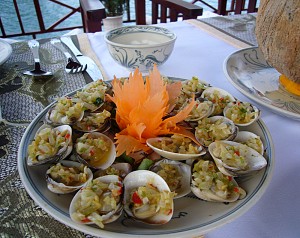 |
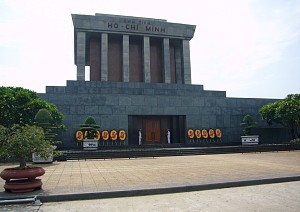 Ho Chi Minh’s Mausoleum. |
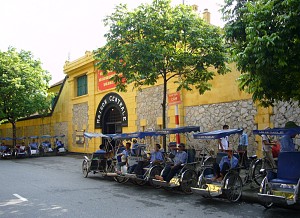 Hoa Lo Prison ("The Hanoi Hilton"). |
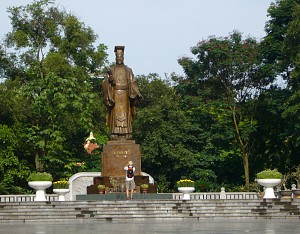 |
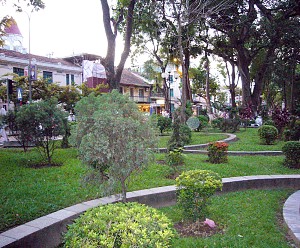 |
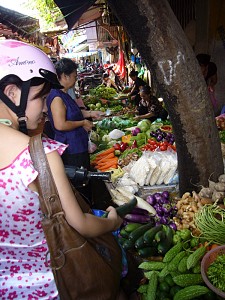 Market in the Old Quaters. |
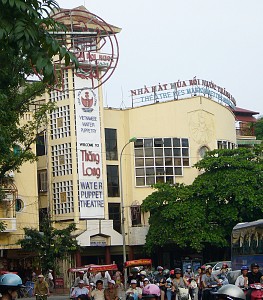 Water Puppet Theatre. |
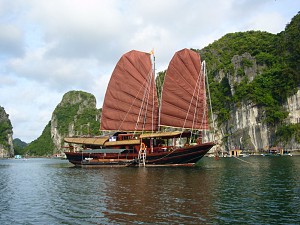 Junk in Ha Long Bay. |
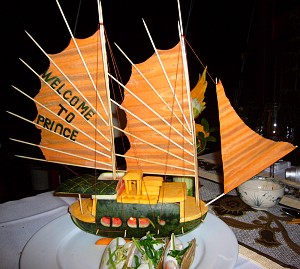 Junk at the dinner. |
